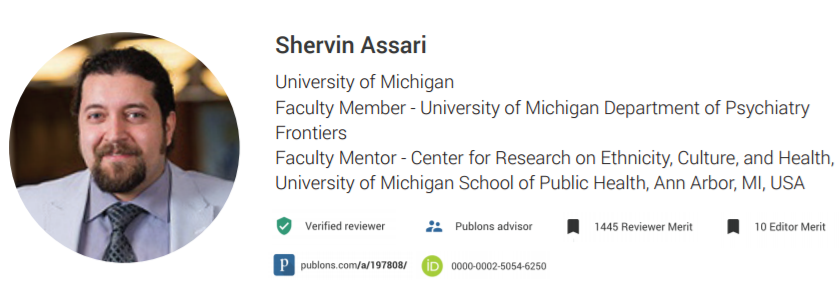
January 19, 2017
Publons puts the spotlight on Shervin Assari, a community mental health researcher at the University of Michigan, Ann Arbor, USA. Recently elected as a Fellow of the New York Academy of Medicine (NYAM), Shervin tells us how his review and editorial services strengthen his bid for fellowships, promotions and grants.
Tell us a bit about the NYAM fellowship:
I was recently elected as a Fellow of the New York Academy of Medicine (NYAM). This is a very prestigious academy with more than 150 years of history in Urban Health. Eligibility required over 10 years work experience and an outstanding contribution to the field of medicine/health.
What was involved in the application process?
I gave my CV and an overview of my academic history to the two people nominating me for the position. They used this to write a recommendation letter, highlighting my contributions across teaching, research and services. Peer review and editorial work falls under services, so two pages of my CV was dedicated to that. Publons automatically tracks my contributions, making my profile and Verified Peer Review Record really useful here. I could prove I’ve reviewed more than 350 papers for 50 journals, and am associate editor of three peerreviewed journals. I also included my best and current ranking on Publons, my university ranking, and the awards I’ve won on the site.
What contributions would you highlight if asked to summarise your editorial services?
I would include a paragraph of maybe four lines on editorial services, and one line on peer review. If the letter is for a general nomination, I’d include all the journals I have reviewed for, and if it’s for a specific nomination, I’d highlight the journals related to that particular field. For example, when applying for a promotion in my department (Psychiatry) a few months ago, I listed the number of psychiatry and mental health journals I’ve reviewed for. That shows I am regarded as an expert by my peers in the field.
In what other applications do you list your peer review contributions?
I’ve also included my editorial and peer review contributions in grant applications. This requires submitting a very specific biosketch tailored to the application, and a personal statement explaining why I qualify to carry out this research. The personal statement is about two thirds of one page, and I usually download my Review Record on Publons to help add a sentence or two in there.
How have your editorial and peer review contributions benefited your own work?
It’s helped me in three ways. First, it has made me a better writer - and that lends itself to writing better research papers and more successful grant applications. My skills as a reviewer help me guess what expectations my own reviewers will have. Second, I am always learning from the papers I review. These papers teach me novel approaches that I hadn’t thought of before, which sometimes inform my own scientific work in the future. Third, having two pages of editorial and peer review history on my CV is a tangible, measurable contribution, which always helps me with my applications.
Can you share one piece of peer review advice for early career researchers?
Sure - don’t be afraid to peer review. Younger reviewers tend to say no if they feel they’re not up to the job. But editors don’t expect you to know everything - and they won’t assume you do either. You’re invited based on your specific expertise, whether it is the methodology, substantive area, or the literature, for example. Accept the invitation and use your strengths, rather than declining outright. And if you’re still worried - tell the editor that your review has not covered a particular aspect of the paper.
